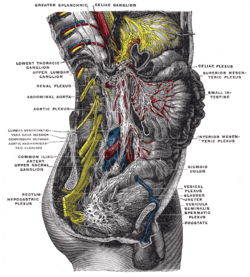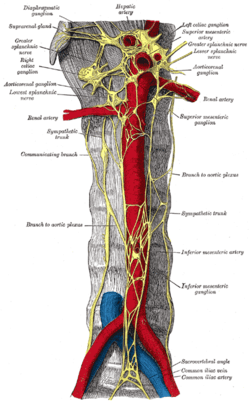Superior hypogastric plexus
The superior hypogastric plexus (in older texts, hypogastric plexus or presacral nerve) is a plexus of nerves situated on the vertebral bodies anterior to the bifurcation of the abdominal aorta.
| Superior hypogastric plexus | |
|---|---|
 The right sympathetic chain and its connections with the thoracic, abdominal, and pelvic plexuses. (Hypogastric plexus is labeled on right, fourth from the bottom.) | |
 Lower half of right sympathetic cord. | |
| Details | |
| Identifiers | |
| Latin | plexus hypogastricus superior, nervus presacralis |
| MeSH | D007001 |
| TA | A14.3.03.046 |
| FMA | 6642 |
| Anatomical terms of neuroanatomy | |
Structure
From the plexus, sympathetic fibers are carried into the pelvis as two main trunks- the right and left hypogastric nerves- each lying medial to the internal iliac artery and its branches. The right and left hypogastric nerves continues as Inferior hypogastric plexus; these hypogastric nerves send sympathetic fibers to the ovarian and ureteric plexuses, which originate within the renal and abdominal aortic sympathetic plexuses. The superior hypogastric plexus receives contributions from the two lower lumbar splanchnic nerves (L1-L2), which are branches of the chain ganglia. They also contain parasympathetic fibers which arise from pelvic splanchnic nerve (S2-S4) and ascend from Inferior hypogastric plexus; it is more usual for these parasympathetic fibers to ascend to the left-handed side of the superior hypogastric plexus and cross the branches of the sigmoid and left colic vessel branches, as these parasympathetic branches are distributed along the branches of the inferior mesenteric artery. The SHP is the continuation of the abdominal aortic plexus.[1]
Relation to the spinal cord
The nerves of the superior hypogastric plexus return to the spinal cord through the lumbar splanchnic nerves.[2]
Proximity to major vasculature
The superior hypogastric plexus or presacral nerve is located in the interiliac triangle overlying the sacral promontory. At this location, the presacral nerve is in close proximity to major vasculature (bifurcation of the aorta, common iliac arteries, left common iliac vein, and inferior mesenteric artery) and the ureters.[2]
Clinical significance
Presacral neurectomy is a laparoscopic procedure where superior hypogastric plexus is excised, so that the pain pathway is cut off from the spinal column. This procedure is done to manage chronic pelvic pain when conservative medical therapy fails.[3]
Additional images
References
- Eid S, Iwanaga J, Chapman JR, Oskouian RJ, Loukas M, Tubbs RS (2018). "Superior Hypogastric Plexus and Its Surgical Implications During Spine Surgery: A Review". World Neurosurg. PMID 30172971.CS1 maint: uses authors parameter (link)
- Ramirez C, Donnellan N. (2017). "Pelvic denervation procedures for dysmenorrhea". Curr Opin Obstet Gynecol. 29 (4): 225–230. doi:10.1097/GCO.0000000000000379. PMID 28683027.CS1 maint: uses authors parameter (link)
- Chen, FP (January 2000). "Laparoscopic presacral neurectomy for chronic pelvic pain". Chang Gung medical journal. 23 (1): 1–7. PMID 10746403.
This article incorporates text in the public domain from page 987 of the 20th edition of Gray's Anatomy (1918)
External links
- Autonomics of the Pelvis - Page 4 of 12 anatomy module at med.umich.edu
- posteriorabdomen at The Anatomy Lesson by Wesley Norman (Georgetown University) (posteriorabdmus&nerves)
- pelvis at The Anatomy Lesson by Wesley Norman (Georgetown University) (pelvicsympathnerves)
- figures/chapter_32/32-6.HTM: Basic Human Anatomy at Dartmouth Medical School
